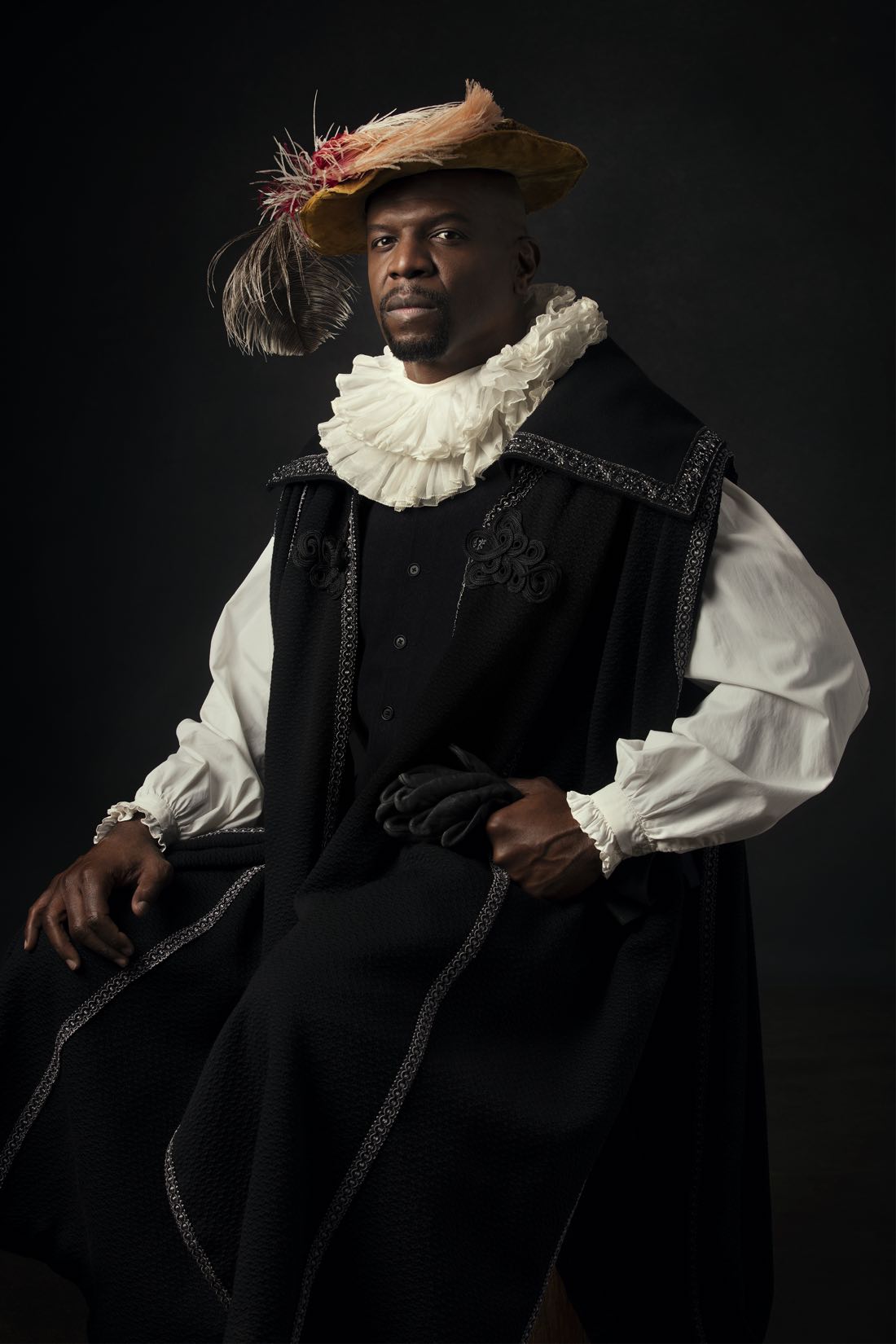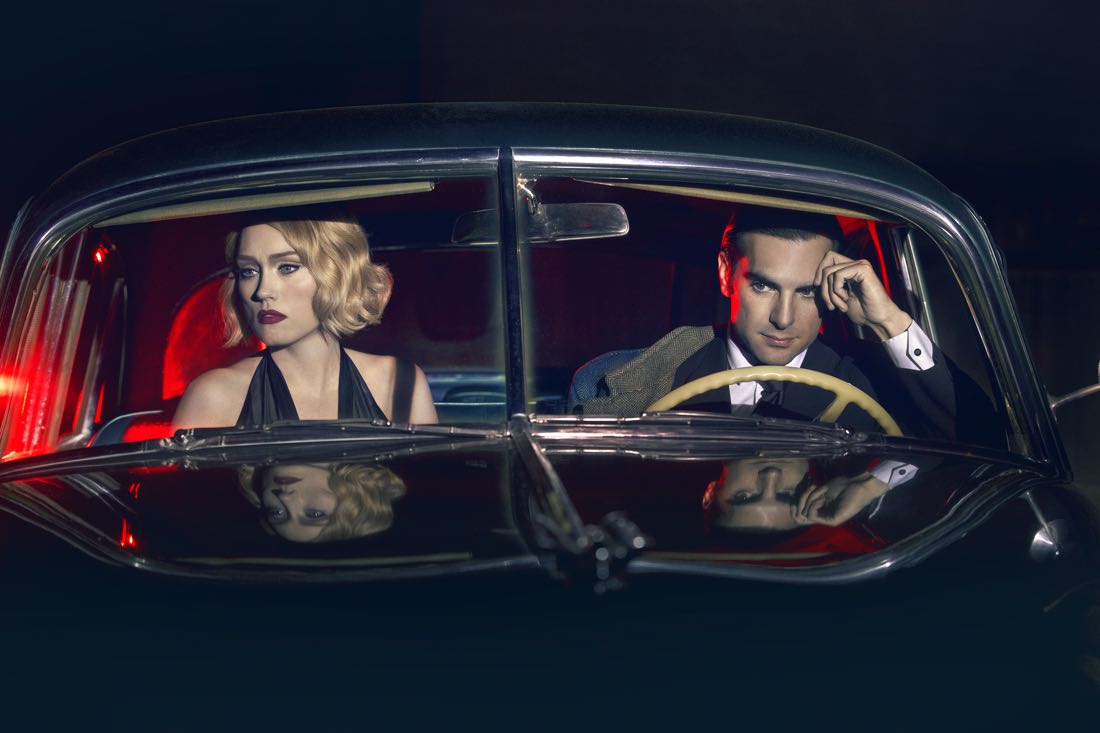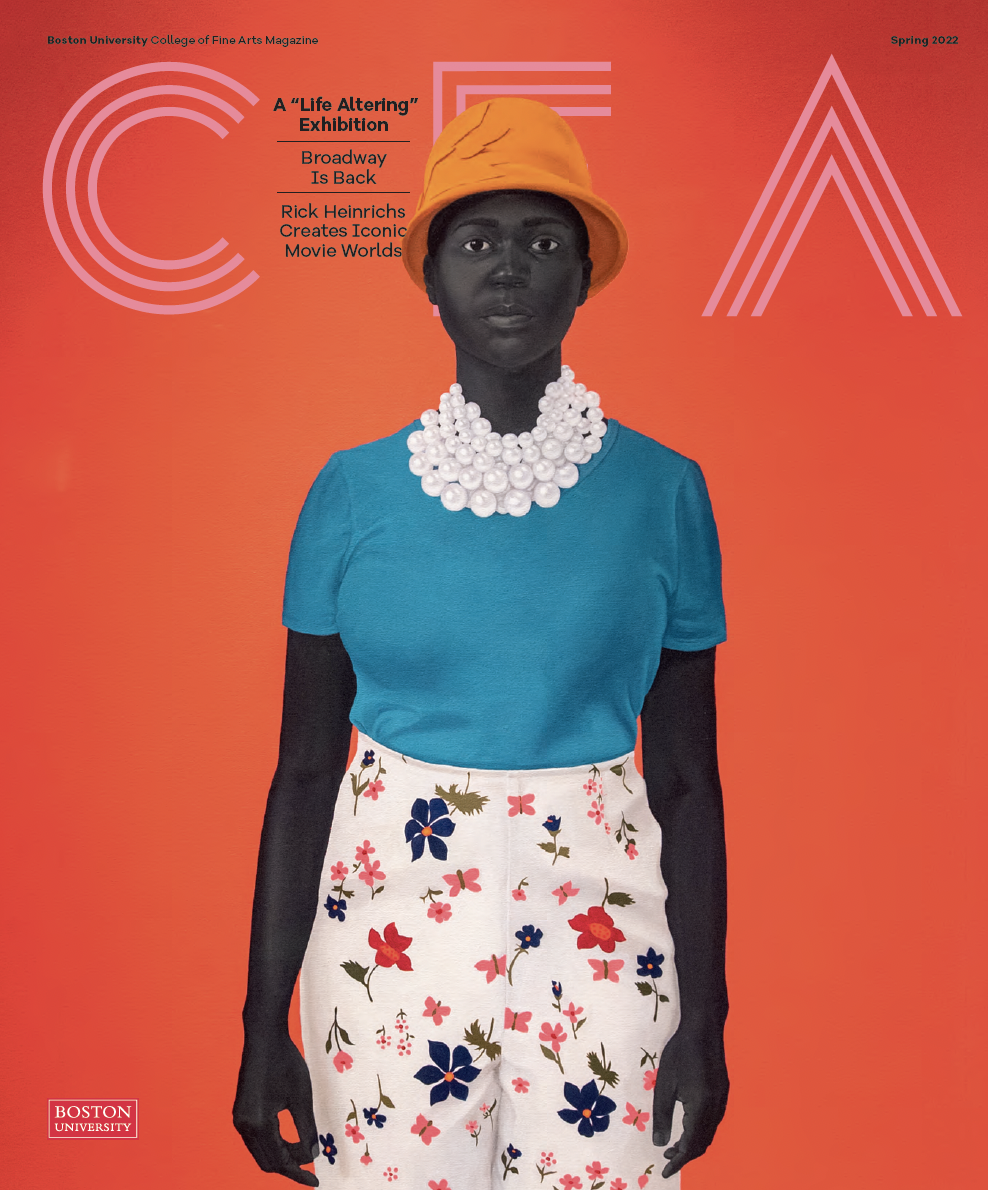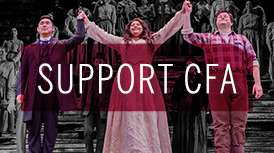Snapshot of the Photographer
The Invisible Wall (2016) is part of Elisabeth Caren’s Double Identity series of photographs inspired by film noir. They play with the rigid gender roles of films of that era.
Elisabeth Caren’s Hollywood career inspires her cinematic photography
By Mara Sassoon
Photos by Elisabeth Caren (’96)
Elisabeth Caren has snapped countless celebrities, including Nicole Kidman, Serena Williams, and Willem Dafoe. She rarely takes a straight portrait, instead pushing stars to reveal something about themselves: In a photo for the entertainment news website TheWrap, actor Darren Criss lurks in the doorway of an elegant room, channeling the serial killer he portrays in the FX crime show The Assassination of Gianni Versace: American Crime Story. In another shoot for TheWrap, Kidman gives the camera a knowing smirk, hinting at the self-destructive cop she plays in the thriller Destroyer.

Ophelia No. 4 (2013) is part of The Feminine Mystique series reimagining female protagonists from classic literature.
Caren (’96) always expected to be in the film business—but not photographing it. She started out as an actor. Caren says being onstage, then in the movie business, taught her how to talk with star entertainers and get their commitment to an artistic vision. Even her advertising and fine art photography share a dramatic, cinematic flair.
At CFA, Caren studied acting and costume design, before realizing she no longer wanted to become an actor. She switched to a major in theatre arts, but after taking a few classes at COM, decided she was most interested in film production. After BU, she made a career in behind-the-scenes movie roles, working in talent agencies and literary management and production companies and trying her hand at production, public relations, and licensing and marketing. She worked with the hottest talent in Hollywood, including directors Mike Newell (Harry Potter and the Goblet of Fire) and Kathryn Bigelow (The Hurt Locker).
In one of her jobs, Caren would often hire event photographers, but a keen amateur photographer, she soon realized that she preferred to photograph the events herself. In 2006, she switched to photography full time, and “my PR and marketing contacts and friends started hiring me,” she says.
The Drama of Portraiture
In 2007, Caren’s friend, producer Josh Gummersall, asked her to shoot production stills for the pilot of his web series, Quarterlife. She learned on the job, shooting for 12-hour days on set and editing the photos at night. “I learned how to stay out of the way, because as a still photographer you are not making the film—you are capturing everyone else making the film and you have to stay as hidden and unobtrusive as possible.”
Caren’s experiences in PR and marketing informed this new role; she knew what the publicists and marketing executives were looking for, and her photos eventually appeared in the New York Times. When the series got picked up by NBC and went union, “that gave me the opportunity to join the International Cinematographers Guild,” she says. She also got to know the actors on the show and conducted editorial photo shoots with them.

For Terry Crews: Renaissance Man (2018), Caren photographed the actor-athlete-visual artist-designer-author-activist in a classic Renaissance portrait to highlight his versatility.
“I came up with the ideas, which were primarily narrative-type portraits, and the actors were extremely collaborative. These shoots built my portfolio and I started pursuing magazine work.”
“I know it can sometimes be a challenge to just be yourself, to be bare in front of the camera,” she says. “Actors are used to being in character, having lines, having an intention, seeing the world through the lens of their character. It can be a wonderful escape from yourself. So, when you are photographed as yourself, you are, in a way, more vulnerable and it can be uncomfortable.”
For a 2018 shoot with actor Terry Crews (Brooklyn Nine-Nine) for Bust magazine, Caren envisioned the entertainer as a literal Renaissance man. “Terry Crews is an athlete, actor, visual artist, designer, author, and activist,” so, in a tongue-in-cheek nod to his versatility, Caren photographed Crews in a classic Renaissance portrait.
“He was so enthusiastic, playful, and inspiring. He really understood what I envisioned and was an incredible collaborator,” Caren says. Crews went all in, posing with a regal expression that complemented his feathered cap, ruffled collar, and black velvet waistcoat. Caren heightened the drama with a Renaissance-esque chiaroscuro style, with its strong contrast between light and dark.
“We were in a studio, so we used a soft strobe light to mimic window light. The intention was for the photo to resemble a Renaissance painting but still look like a photograph,” Caren says. “I like the tension between recognizing and honoring the past but using modern technology to bring the past and present together.”
Art of Photography
In commercial work, Caren cedes some of her creative control to the client, she says, but “my fine art photography comes completely from me.”
Caren has made a breadth of stunning fine art photography informed by her longtime fascination with classical paintings and her passion for the dramatic and cinematic arts. Her work has been exhibited in galleries both nationally and internationally.
“At any given time, I have at least a dozen ideas of projects I want to do. Some are a decade old or older—they are always in my mind somewhere and kind of rest on my shoulders in an uncomfortable way until I can get them out.”

Pygmalion and Galatea No. 1 (2014) is part of Caren’s series Pygmalion and Galatea, based on the Greek myth of the same name.
Many of her fine art series have a feminist bent and explore a struggle for equality. Her ongoing series The Feminine Mystique, a titular homage to Betty Friedan’s 1963 book, comprises reimaginings of female protagonists from classic literature. Some photos in the series center around Ophelia, the main love interest from Shakespeare’s Hamlet, who is driven mad with grief and drowns. In Ophelia No. 4 (2013), a woman falls into deep blue water, her face obscured by a splash, only a hint of her silky dress visible. The dynamic shot features beads of water jumping out of the composition.
In other artistic interpretations of Ophelia, “this tragic figure seems to always be depicted as floating peacefully,” Caren says. “I was curious as to why we’ve never seen the moments before she was in the water, falling, and wanted to explore the possibility that it may have been a tempestuous moment for her. I questioned how we would feel about the iconic ingénue given our knowledge and perspective of women and mental illness today.”
Another series, Pygmalion and Galatea, references the Greek myth of the same name in which sculptor Pygmalion creates an ivory statue of a woman and falls in love with it. In the myth, the Greek goddess of love, Aphrodite, grants his wish to animate the statue, and he marries her.
“In my interpretation, what Pygmalion thought of as a ‘perfect’ woman was not actually a human being—she had no voice, no emotion, no desires,” Caren says. “She was whatever Pygmalion projected onto her, and when she becomes flesh and blood, the couple faces conflicts and disappointments and the reality that no human is perfect.”
In Pygmalion and Galatea No. 1 (2014), Pygmalion strains to grasp the statue on the pedestal in front of him. In four successive photos, the couple transitions from passion to anguish.
Breaking Out of Black and White
Caren’s personal photography is also influenced by the film industry she knows so well. Her series Double Identity, for instance, is inspired by film noir, but plays with the rigid gender roles of the films of that era, aiming to “examine realities of humanity that were excluded from these films.”
The series depicts men and women interacting with each other in purposely vague contexts. Caren shot each photo as if it were a production still and titled each one after a classic 1940s noir film.
In those films, “the leading female usually fell into two character types: the femme fatale, who uses her sexual attractiveness and cunning to manipulate men, as it’s her only option to gain power and independence, and the conventional devoted wife and mother, typically portrayed as dull, who has no autonomy.”

The Last Mile (2016) belongs to Caren’s Double Identity series.
Caren flips these archetypes in a photo from the series titled The Invisible Wall (2016), a lush image of a redlipped woman tending roses in an overgrown garden. She wears a look of intense concern, but the viewer is not permitted access to the object of her gaze. Though she is in the midst of a household chore, she is anything but dull, dressed in an elegant coral satin gown.
“Meanwhile, the leading man in film noir is either a tough guy who cannot show emotion,” says Caren, “or the socially alienated man who is thrust into a confusing situation where he is vulnerable, especially when encountering the femme fatale.”
In The Last Mile (2016), Caren portrays a glamorous man and woman sitting in a 1940s-era car. As they gaze off into the distance, the windshield creates a visual divide between them and a dramatic red light glows behind them. Caren’s use of vivid color in this series “represents that we, as a society, have come a long way in our acknowledgment and acceptance of contrast and diversity in relationships and identity, and that life is not as black and white as Hollywood had wanted us to believe.”










